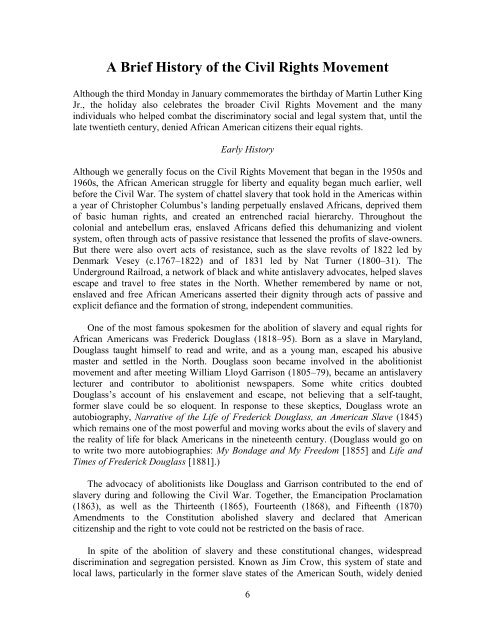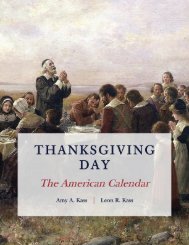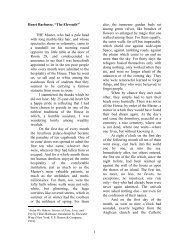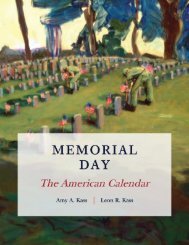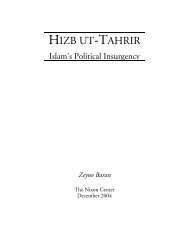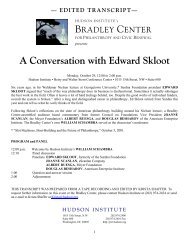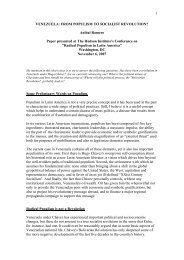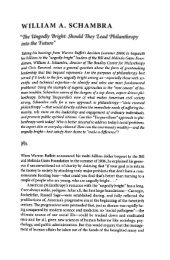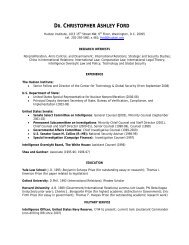Download PDF - Hudson Institute
Download PDF - Hudson Institute
Download PDF - Hudson Institute
Create successful ePaper yourself
Turn your PDF publications into a flip-book with our unique Google optimized e-Paper software.
A Brief History of the Civil Rights Movement<br />
Although the third Monday in January commemorates the birthday of Martin Luther King<br />
Jr., the holiday also celebrates the broader Civil Rights Movement and the many<br />
individuals who helped combat the discriminatory social and legal system that, until the<br />
late twentieth century, denied African American citizens their equal rights.<br />
Early History<br />
Although we generally focus on the Civil Rights Movement that began in the 1950s and<br />
1960s, the African American struggle for liberty and equality began much earlier, well<br />
before the Civil War. The system of chattel slavery that took hold in the Americas within<br />
a year of Christopher Columbus’s landing perpetually enslaved Africans, deprived them<br />
of basic human rights, and created an entrenched racial hierarchy. Throughout the<br />
colonial and antebellum eras, enslaved Africans defied this dehumanizing and violent<br />
system, often through acts of passive resistance that lessened the profits of slave-owners.<br />
But there were also overt acts of resistance, such as the slave revolts of 1822 led by<br />
Denmark Vesey (c.1767–1822) and of 1831 led by Nat Turner (1800–31). The<br />
Underground Railroad, a network of black and white antislavery advocates, helped slaves<br />
escape and travel to free states in the North. Whether remembered by name or not,<br />
enslaved and free African Americans asserted their dignity through acts of passive and<br />
explicit defiance and the formation of strong, independent communities.<br />
One of the most famous spokesmen for the abolition of slavery and equal rights for<br />
African Americans was Frederick Douglass (1818–95). Born as a slave in Maryland,<br />
Douglass taught himself to read and write, and as a young man, escaped his abusive<br />
master and settled in the North. Douglass soon became involved in the abolitionist<br />
movement and after meeting William Lloyd Garrison (1805–79), became an antislavery<br />
lecturer and contributor to abolitionist newspapers. Some white critics doubted<br />
Douglass’s account of his enslavement and escape, not believing that a self-taught,<br />
former slave could be so eloquent. In response to these skeptics, Douglass wrote an<br />
autobiography, Narrative of the Life of Frederick Douglass, an American Slave (1845)<br />
which remains one of the most powerful and moving works about the evils of slavery and<br />
the reality of life for black Americans in the nineteenth century. (Douglass would go on<br />
to write two more autobiographies: My Bondage and My Freedom [1855] and Life and<br />
Times of Frederick Douglass [1881].)<br />
The advocacy of abolitionists like Douglass and Garrison contributed to the end of<br />
slavery during and following the Civil War. Together, the Emancipation Proclamation<br />
(1863), as well as the Thirteenth (1865), Fourteenth (1868), and Fifteenth (1870)<br />
Amendments to the Constitution abolished slavery and declared that American<br />
citizenship and the right to vote could not be restricted on the basis of race.<br />
In spite of the abolition of slavery and these constitutional changes, widespread<br />
discrimination and segregation persisted. Known as Jim Crow, this system of state and<br />
local laws, particularly in the former slave states of the American South, widely denied<br />
6


